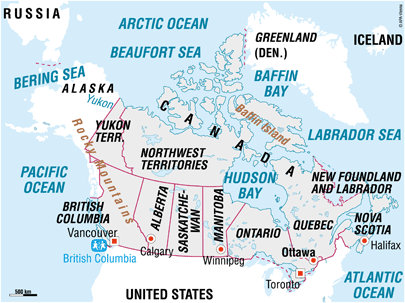
Vi er i Canada
Some facts about Canada
Canada became a self-governing nation in 1867 while still retaining ties to the British crown. At present, the total population of Canada is roughly 34,000 million and its capital city is Ottawa.
As the country has one of the highest per capita immigration rates in the world, it has always been considered a melting pot of different cultures and customs.
After the English Canadians, French Canadians represent the second largest ethnic group in Canada, primarily inhabiting the province of Quebec. Separatist movements in francophone Canada remain an important domestic issue.
While Canada is the second largest country in the world by surface, it is very sparsely populated. Canada, along with Mexico and the United States of America, has signed the North American Free Trade Agreement (NAFTA).
Canada remains a rich country with great disparities
HIV/AIDS has become a growing problem within the Aboriginal Canadian community. While the overall prevalence of HIV/AIDS is roughly 0.5 per cent, it is nearly three times higher for Canadians of aboriginal descent. Nearly 30 per cent of infected people in Canada do not even know they have HIV.
In spite of the fact that Canada is a very developed country, income inequality has been on a steady rise throughout the last decade. The gap between the rich and the poor has been getting wider. Wealthy Canadians are particularly wealthy when compared to their counterparts in other developed countries.
Situation of the children in Canada
A significant number of children without parental support end up getting trapped in a vicious circle of drug abuse, gang life and violence. In Vancouver, roughly 75 per cent of the city’s street young people use crystal meth (“meth”), a dangerous psycho-stimulant drug.
Children represent the population segment that has been most affected by the general increase in poverty levels. According to the OECD, roughly 15 per cent of children are living in poverty. In fact, out of nearly all OECD member countries, Canada has seen one of the highest increases in the child poverty rate over recent years.
SOS Children's Villages in Canada
Canadian's wishing to support SOS Children's Villages are encouraged to sponsor a child, sponsor a village or to make a direct donation. Your support ensures that SOS Children's Villages can continue to provide a safe and loving home to orphaned, abandoned and other vulnerable children worldwide.
Website of SOS Children's Villages Canada
(available in English and in French)